7 Proven Job Interview Practice Methods for 2025
In a competitive job market, simply rehearsing answers in your head won't cut it. The hiring process has evolved, with video interviews, behavioral assessments, and AI-driven screening now commonplace. To truly stand out, you need a multi-faceted approach to job interview practice that builds not just knowledge, but confidence, poise, and strategic communication skills. Traditional methods often miss critical nuances, like conveying positive body language in a virtual setting or the art of telling a compelling career story that resonates with hiring managers.
This guide moves beyond generic advice to provide a comprehensive roundup of seven powerful, actionable practice methods. Each technique is designed to target a specific interview skill set, helping you transform from a nervous candidate into a prepared professional. You will learn concrete strategies for every part of the interview, from structuring your answers with the STAR method to confidently navigating salary negotiations. By focusing on these specific areas, you can develop the skills needed to master any interview format and secure your target role. Let's dive into the strategies that will give you a decisive edge.
1. STAR Method Practice
Behavioral interview questions, which often start with "Tell me about a time when…", are designed to gauge your past performance as an indicator of future success. The STAR method provides a structured and powerful framework for answering these questions clearly and effectively. It ensures your answers are concise, compelling, and directly linked to tangible outcomes, making it a cornerstone of effective job interview practice.
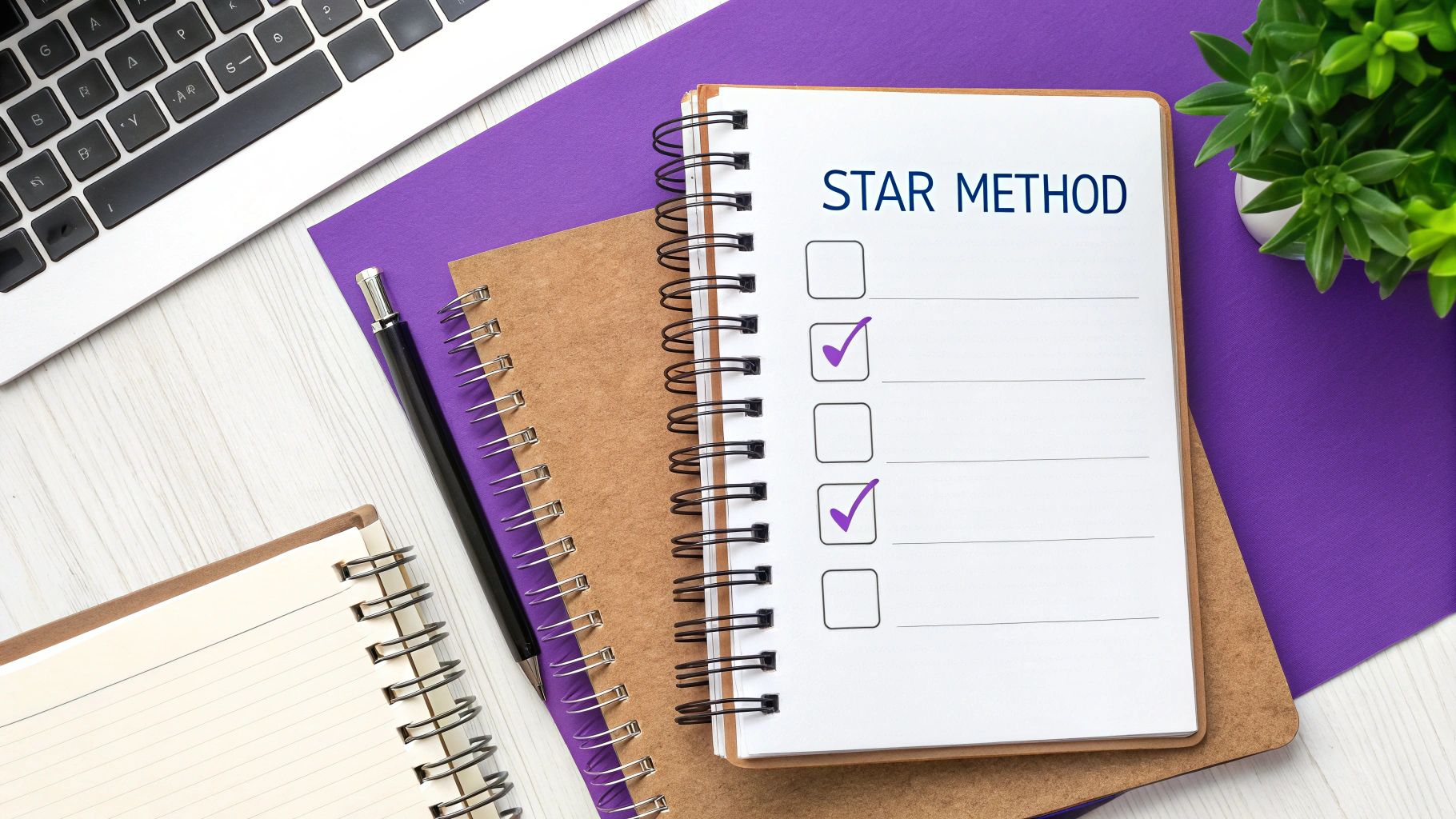
The acronym stands for a four-part narrative structure:
- S – Situation: Briefly describe the context. Where and when did this happen? What was your role?
- T – Task: Explain the specific challenge or responsibility you were assigned. What goal were you working toward?
- A – Action: Detail the specific steps you took to address the task. Focus on your individual contributions, using "I" statements.
- R – Result: Quantify the outcome of your actions. What was the positive result? What did you accomplish? What did you learn?
How to Master STAR for Your Interview
To effectively integrate this into your job interview practice, don't just understand the concept; actively prepare specific stories. Begin by brainstorming 5-7 significant accomplishments from your career that align with common competencies like leadership, teamwork, problem-solving, and initiative.
Next, write out each story using the STAR framework. For instance, when asked about handling a tight deadline:
Situation: "In my previous role as a project coordinator, our team was tasked with launching a new marketing campaign for a key client."
Task: "Just three days before the launch, the client requested a major change to the creative assets, putting our original deadline at risk."
Action: "I immediately organized a brief emergency meeting with the design and copy teams to re-prioritize tasks. I then created a revised mini-project plan and personally handled the client communication to manage expectations, providing hourly updates."
Result: "As a result, we delivered the revised campaign assets on time, and the client was so impressed with our agility that they signed a 15% larger contract for the following quarter."
Focus on keeping your responses to a concise 2-3 minutes. The power of this method lies in its structure and impact, preventing you from rambling while demonstrating your value with concrete evidence. For those looking to streamline this process, you can explore tools like an interview answer generator to help structure your thoughts.
2. Mock Interview Simulations
Beyond preparing answers in isolation, mock interview simulations are crucial for experiencing the pressure and dynamics of a real interview. These practice sessions replicate the conditions of an actual meeting, allowing you to get comfortable with the format, timing, and interaction. This form of job interview practice is essential for building confidence and receiving actionable feedback on your overall performance, from body language to the clarity of your responses.
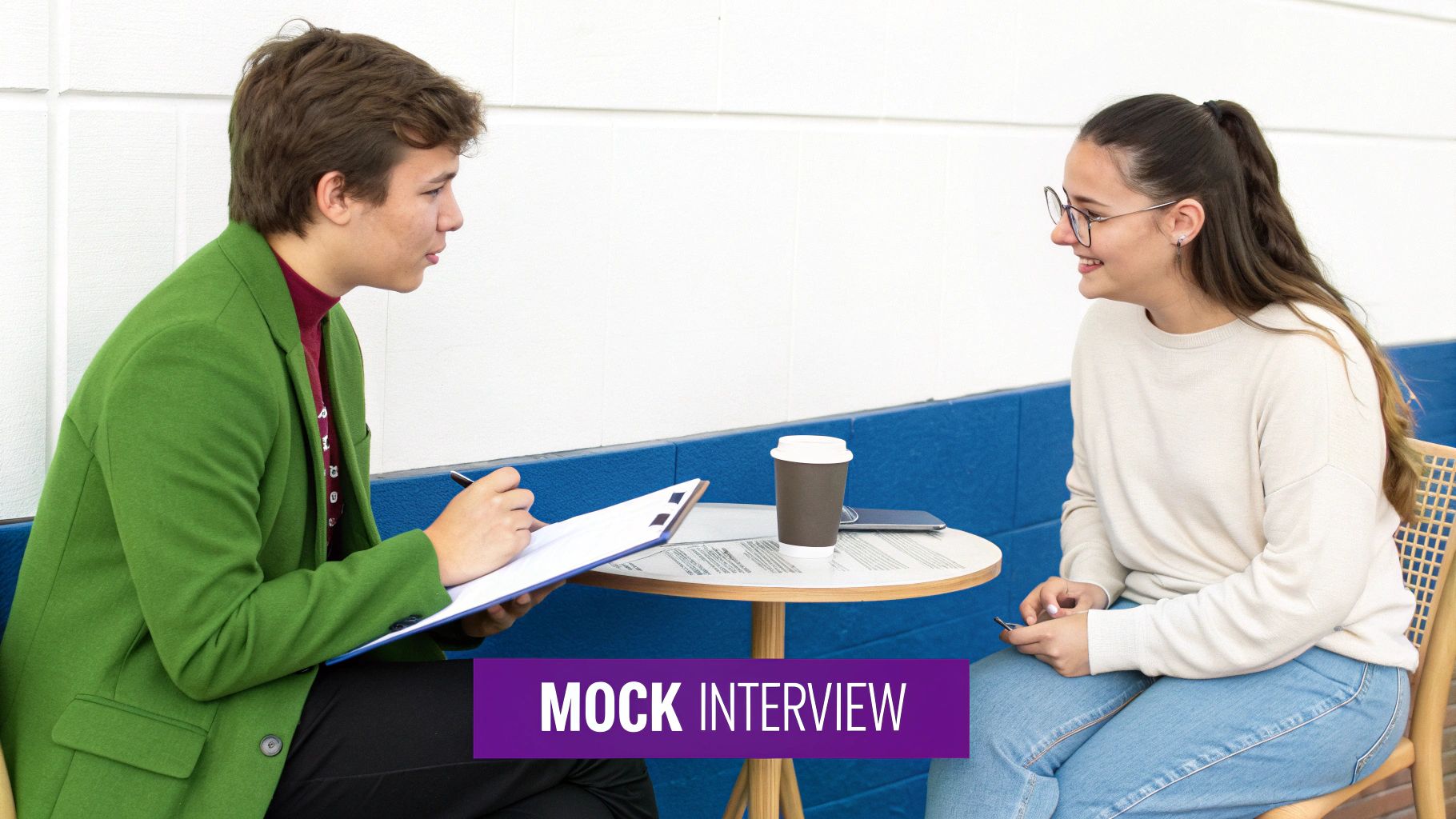
A mock interview involves a simulated Q&A session with a partner who acts as the interviewer. This partner could be a friend, a mentor, a professional career coach, or even an AI-powered platform. The goal is to go through the motions of an entire interview to identify areas for improvement.
Key benefits of this practice include:
- Reducing Anxiety: Familiarity with the interview process significantly lowers stress on the actual day.
- Improving Pacing: You learn to deliver thoughtful answers without rushing or rambling.
- Receiving Feedback: An external observer can spot weaknesses you might miss, such as using filler words or poor non-verbal cues.
- Testing Technology: For virtual interviews, it's a perfect chance to ensure your camera, microphone, and internet connection are reliable.
How to Get the Most Out of Mock Interviews
To make your simulations effective, approach them with a clear strategy. Don't just go through the motions; treat each session as a genuine opportunity to refine your skills. Start by finding a suitable practice partner or platform. University career centers often provide this service for students, while platforms like Pramp offer peer-to-peer technical mock interviews, and services such as InterviewBuddy connect you with industry experts.
Next, establish the conditions for the simulation:
Set a specific time, dress in your planned interview attire, and find a quiet space free from interruptions. Provide your partner with the job description for the role you are targeting so they can ask relevant questions. If possible, record the session. Watching yourself later provides invaluable insights into your body language, tone, and mannerisms.
After the session, dedicate ample time to the feedback process. Ask your partner for specific, constructive criticism. Instead of asking "How did I do?", ask "What was the weakest part of my answer to the problem-solving question?" or "Did I seem confident when discussing my experience?" Focus on improving one or two key areas in your next job interview practice session to ensure steady, measurable progress.
3. Video Interview Practice
With the rise of remote work, mastering the virtual interview has become non-negotiable. Video interviews, conducted over platforms like Zoom, Teams, or specialized software like HireVue, introduce unique challenges that go beyond answering questions well. This type of job interview practice is crucial for mastering the technical setup, on-camera presence, and digital communication nuances that define modern hiring.
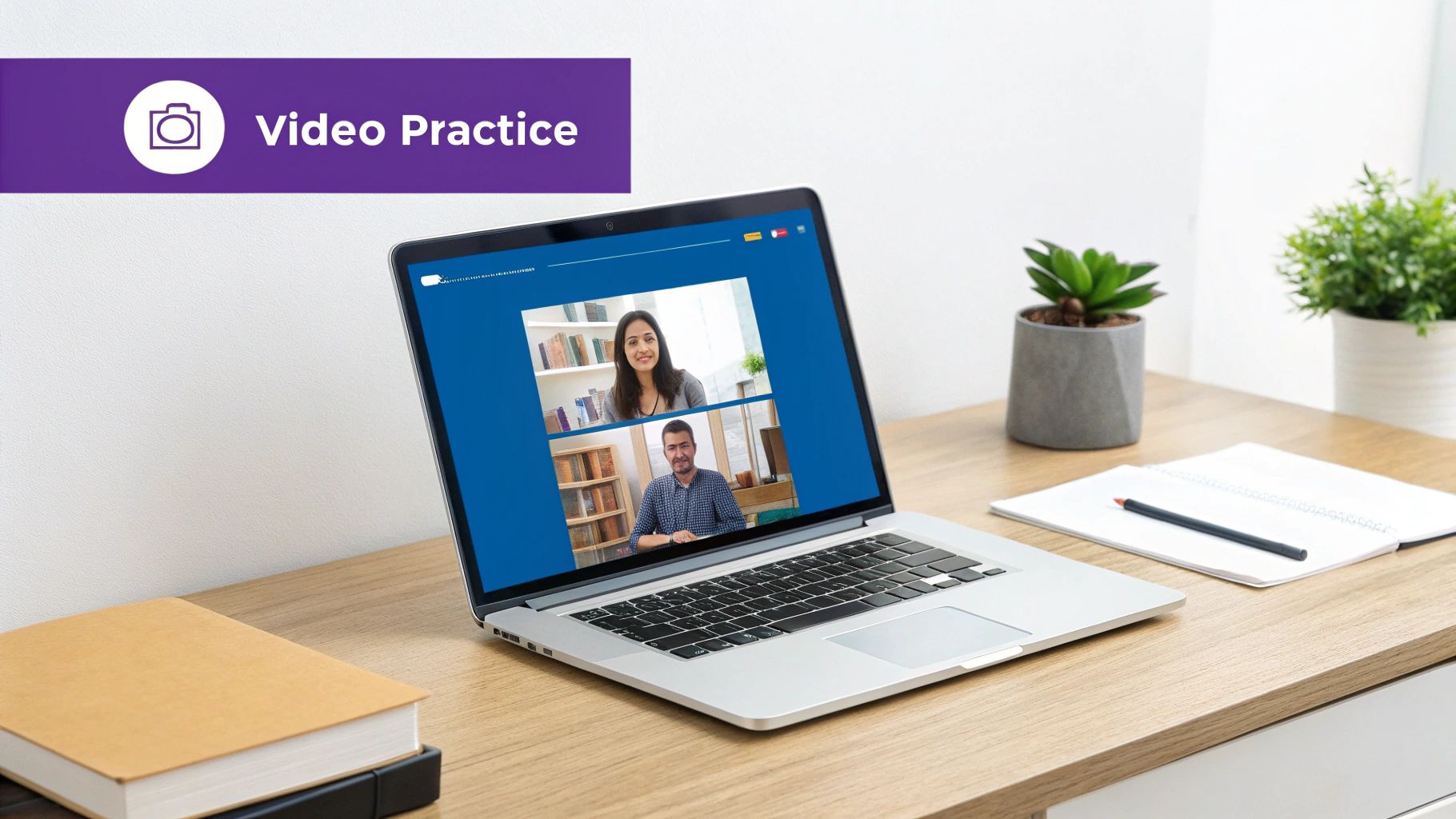
Unlike in-person meetings, virtual interviews are judged on both your answers and your digital professionalism. Your ability to manage the technology smoothly is seen as a proxy for your adaptability and remote work readiness. Factors like lighting, background, and internet stability all contribute to the impression you make.
How to Master Video Interviews
Effective practice involves more than just launching a video call. You need to simulate the entire experience, from the technical check to signing off professionally. This ensures you are prepared for both the conversational and technical aspects of the interview.
Start by recording yourself answering common interview questions. You can use your computer's built-in camera software or set up a mock Zoom call with a friend. Pay close attention to these key areas:
- Technology & Setup: Test your camera, microphone, and internet connection at least 24 hours beforehand. Ensure your background is clean and professional, and that you are lit from the front to avoid shadows.
- Camera Presence: The biggest challenge is making a personal connection through a screen. Practice looking directly into the camera lens, not at the image of the interviewer on your screen. This simulates direct eye contact and builds rapport.
- Non-Verbal Cues: Sit up straight, nod to show you're listening, and use hand gestures naturally. Your body language is still a critical part of communication, even through a webcam.
For example, a candidate preparing for a role at a distributed company should treat their practice sessions like the real thing:
Dress in your planned interview attire. Set up your lighting and test your audio by recording a short clip. Then, ask a friend to run a 30-minute mock interview over the same platform the company will use. Afterwards, review the recording together to critique everything from the clarity of your answers to whether you fidgeted or looked away from the camera too often.
This dedicated job interview practice helps you troubleshoot technical issues and build the on-camera confidence needed to let your qualifications shine through, making the technology feel invisible during the actual interview.
4. Industry-Specific Question Drills
While general interview questions assess your soft skills, industry-specific questions evaluate your technical expertise, domain knowledge, and understanding of your field's unique challenges. Focusing your preparation on these questions demonstrates to employers that you are not just a capable professional but also a specialist who can add immediate, relevant value. This targeted approach is a crucial component of advanced job interview practice.
These drills involve researching and rehearsing answers to questions that are unique to a specific job function or industry. This goes beyond standard behavioral questions and dives into the technical, situational, and strategic scenarios you will face in the role.
- Software Engineers: Practicing live coding challenges and system design questions.
- Marketing Professionals: Preparing to dissect a case study or outline a go-to-market strategy for a hypothetical product.
- Healthcare Workers: Reviewing patient care scenarios, ethical dilemmas, and questions about new medical regulations.
- Financial Analysts: Walking through a discounted cash flow (DCF) model or discussing recent market trends.
How to Master Industry-Specific Drills
To excel, your preparation must be deep and current. Generic answers won't suffice when an interviewer is testing your specific knowledge. Start by identifying the core competencies and technical skills listed in the job description.
Next, research recent developments, challenges, and trends within that industry. For instance, a candidate in the renewable energy sector should be prepared to discuss the impact of new government policies or battery storage technology.
Example (Digital Marketing): An interviewer asks, "How would you improve the user engagement on our e-commerce platform's product pages?"
A prepared candidate might respond: "First, I'd analyze the current user behavior data in Google Analytics to identify drop-off points. Based on that, I'd propose A/B testing several elements. This could include adding user-generated content like photo reviews, implementing a 'compare' feature, and optimizing the mobile UX with a sticky 'add to cart' button. I’d track metrics like bounce rate, time on page, and conversion rate to measure the impact of each change."
This type of answer demonstrates both strategic thinking and hands-on technical familiarity. To build a robust list of potential questions for your field, using a specialized tool can be highly effective. You can find targeted questions with an interview question generator to ensure your practice sessions are as relevant as possible.
5. Body Language and Non-Verbal Communication Practice
Your words are only half the story; how you present yourself non-verbally can significantly influence an interviewer's perception of your confidence and credibility. Practicing body language involves developing a conscious awareness of your posture, gestures, and facial expressions to ensure they align with the professional, competent image you want to project. This form of job interview practice is crucial because strong non-verbal cues can build rapport and reinforce the message you're delivering.
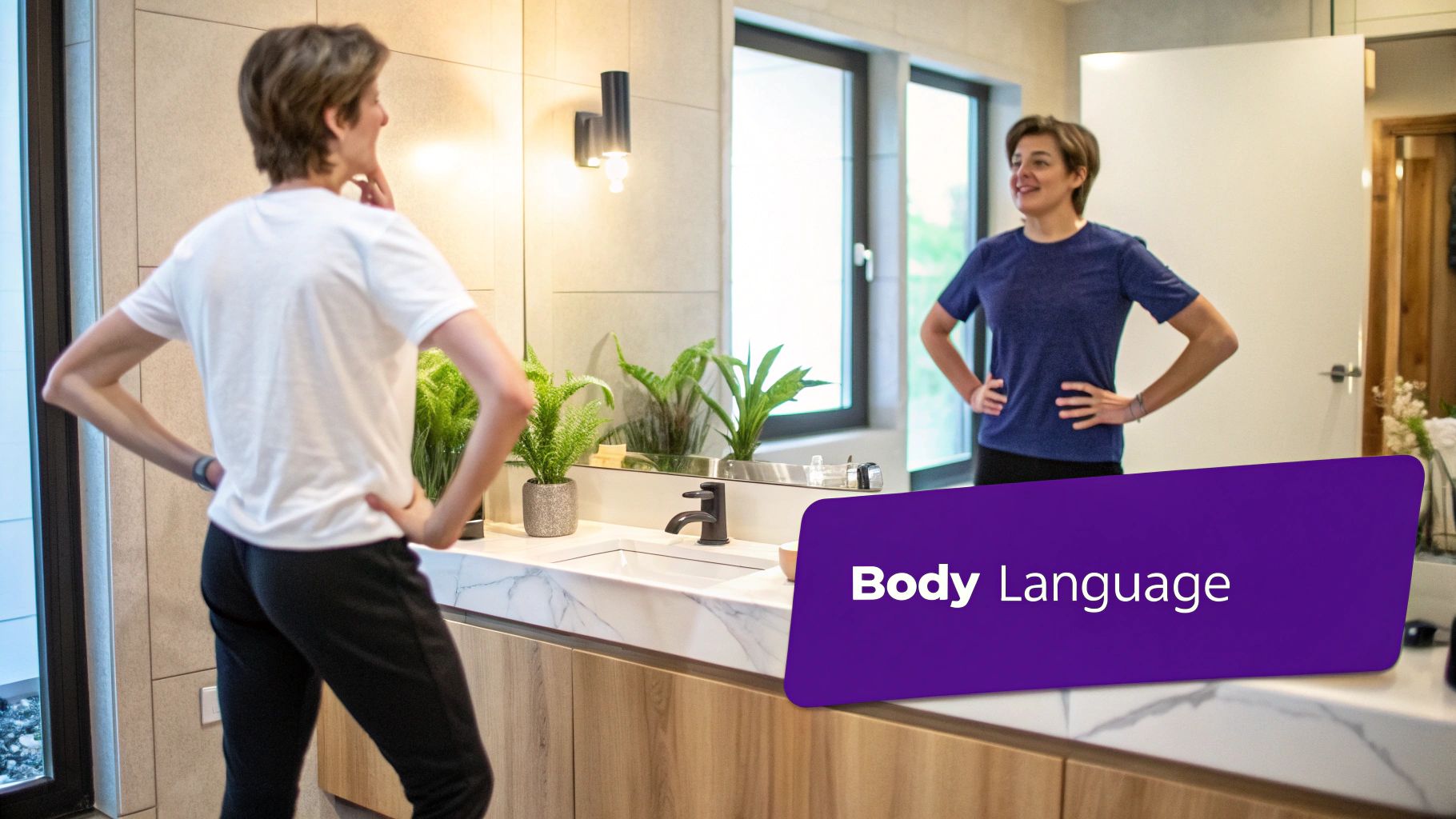
The core idea, popularized by experts like Harvard professor Amy Cuddy, is that your physical presence can shape not only how others see you but also how you feel about yourself. Adopting confident body language can actually boost your feelings of power and reduce stress.
- Posture: Sit upright with your shoulders back to convey confidence and engagement. Avoid slouching, which can be interpreted as disinterest.
- Eye Contact: Maintain steady, but not intense, eye contact. A good guideline is the 50/70 rule: hold eye contact about 50% of the time while speaking and 70% while listening.
- Gestures: Use open-hand gestures to emphasize points and appear approachable. Avoid fidgeting or crossing your arms, which can create a defensive barrier.
- Facial Expressions: A genuine smile can build instant rapport. Ensure your expressions match the tone of your conversation, showing enthusiasm and active listening.
How to Master Body Language for Your Interview
The key to improving non-verbal communication is self-awareness, which comes from observation and repetition. Start by recording yourself answering common interview questions. Watch the playback with the sound off to focus solely on your physical cues.
A powerful pre-interview technique is "power posing," as discussed in Amy Cuddy's famous TED Talk.
Before your interview, find a private space like a restroom and stand in a high-power pose (e.g., hands on hips, feet apart) for two minutes. Research suggests this can increase testosterone (the confidence hormone) and decrease cortisol (the stress hormone), helping you walk into the room with a more commanding presence.
Example Application: During a virtual interview, make sure your camera is at eye level. Looking down at the camera can make you appear subservient, while looking up can seem arrogant. Frame yourself from the chest up so your hand gestures are visible. Before answering a question, take a calm breath and offer a slight nod to show you're engaged and ready to respond thoughtfully. This small, controlled movement demonstrates poise and prevents you from rushing your answer.
6. Storytelling and Personal Branding Practice
Beyond answering individual questions, a successful interview involves weaving a cohesive narrative about who you are, what you've accomplished, and where you're going. Storytelling and personal branding practice focuses on crafting this compelling narrative, ensuring every answer contributes to a consistent and memorable professional identity that resonates with the employer. This strategic approach transforms you from a candidate into a clear solution for the company's needs.
This practice moves beyond simple facts to connect your experiences with your career aspirations and the specific role. It's about demonstrating not just what you did, but why it matters and how it aligns with the company’s vision and values. A strong personal brand is fundamental to standing out, and understanding how to create a personal brand is a key step in this process.
How to Master Storytelling for Your Interview
Effective personal branding during an interview requires preparation and a clear strategy. This form of job interview practice helps you define and communicate your unique value proposition.
Start by developing 3-5 core "pillar" stories that highlight your key strengths, such as resilience, innovation, or leadership. These are versatile narratives that can be adapted to answer a wide range of questions.
Next, frame these stories with a clear beginning, middle, and end, much like a TED Talk. Ensure each story connects your past actions to your future potential within the target company. For example, when asked about your greatest weakness:
"In my early career, I was so focused on executing my own tasks perfectly that I sometimes missed opportunities to proactively support my teammates. I realized this after a project where a colleague was struggling to meet a deadline I could have easily helped with. Since then, I’ve made a conscious effort to regularly check in with my team, offering assistance and sharing resources. This has not only improved our team's overall efficiency but has also made me a more collaborative and, I believe, more effective leader."
This approach reframes a weakness into a story of self-awareness and growth, reinforcing a positive brand attribute. Think of your interview as a story with you as the protagonist and the job as the next logical chapter. For help articulating this brand in writing, a resume summary generator can be a useful tool for crystallizing your core message.
7. Salary Negotiation and Compensation Discussion Practice
Discussing money can be one of the most stressful parts of the hiring process, yet it is arguably the most impactful on your career. Dedicated practice for salary and compensation talks transforms this high-stakes conversation from a source of anxiety into an opportunity to secure the value you deserve. This specialized job interview practice prepares you to navigate these discussions with confidence, strategy, and professionalism.
This practice involves more than just picking a number; it’s about articulating your value and understanding the full scope of a compensation package. It moves the conversation from a simple request to a collaborative negotiation based on data and performance.
- Research: Thoroughly investigate industry-standard salary ranges for your role, experience level, and geographic location using sites like Glassdoor, Levels.fyi, and Payscale.
- Scripting: Develop and practice responses to common compensation questions, such as "What are your salary expectations?"
- Role-Playing: Simulate the negotiation with a friend or mentor to build confidence and refine your delivery.
- Total Compensation Focus: Learn to evaluate and discuss the entire package, including base salary, bonuses, equity (stock options), benefits, and perks.
How to Master Compensation Discussions in Your Interview
Effective negotiation practice begins long before the interview. It requires preparation and a clear understanding of your goals and boundaries. Start by defining your ideal salary, your acceptable salary, and your firm walk-away point.
Next, craft your responses. When asked about salary expectations early in the process, a well-practiced, professional deflection can be powerful:
Interviewer: "Before we go further, what are your salary expectations for this role?"
Prepared Response: "That's a great question. Right now, my main focus is on learning more about this opportunity to see if we have a mutual fit. I'm confident that if we both feel this is the right role, we can agree on a compensation package that is fair and competitive for the value I'll bring."
This approach, popularized by experts like Ramit Sethi, shifts the focus back to your qualifications and delays the numbers talk until you have more leverage, ideally after an offer has been extended. Practicing this and other scenarios ensures you can respond calmly and strategically, rather than being caught off guard. This focused job interview practice can directly result in a significantly higher compensation package, setting a new baseline for your future earnings.
7-Method Interview Practice Comparison
| Practice Type | Implementation Complexity 🔄 | Resource Requirements ⚡ | Expected Outcomes 📊 | Ideal Use Cases 💡 | Key Advantages ⭐ |
|---|---|---|---|---|---|
| STAR Method Practice | Moderate – requires structured preparation | Low to Moderate – mostly time for developing stories | Clear, organized answers highlighting achievements | Behavioral interviews emphasizing skills and impact | Easy to remember; highlights measurable results |
| Mock Interview Simulations | High – coordination with partners or platforms | Moderate to High – access to interviewers/tech | Improved confidence and communication; anxiety reduction | Realistic interview practice with feedback | Real-time feedback; builds interview stamina |
| Video Interview Practice | Moderate – requires tech setup and environment prep | Moderate – equipment and platform access | Mastery of virtual interview skills; tech troubleshooting | Virtual/remote interview preparation | Allows self-review; develops digital presence |
| Industry-Specific Question Drills | High – involves extensive research | Moderate – access to industry resources | Strong technical knowledge; industry-specific readiness | Technical or niche roles with specific question types | Highly targeted preparation; demonstrates expertise |
| Body Language and Non-Verbal Communication Practice | Low to Moderate – mainly self-practice | Low – mirror or recording device | Enhanced confidence and positive presence | Improving physical interview presence | Improves first impressions; reduces anxiety |
| Storytelling and Personal Branding Practice | Moderate to High – time-intensive story crafting | Low to Moderate – time and coaching may help | Memorable, engaging personal narratives | Interviews valuing communication and personal fit | Differentiates candidate; builds emotional connection |
| Salary Negotiation and Compensation Discussion Practice | Moderate – requires preparation and strategy | Moderate – market research tools and guidance | Improved negotiation outcomes and confidence | Compensation discussions during or post interview | Increases compensation potential; shows professionalism |
Turning Practice into an Unbeatable Performance
Navigating the modern job market requires more than just a stellar resume; it demands a polished, confident, and authentic interview performance. The seven methods we've explored provide a comprehensive toolkit for transforming your potential into a compelling offer. This isn't about rote memorization, but about building genuine communication muscle.
Think of each practice method as a different workout in a complete training regimen.
- STAR Method Drills build the foundational strength for structured, impactful answers.
- Mock Interview Simulations test your endurance and adaptability under realistic pressure.
- Video Recording and Analysis acts as a mirror, sharpening your on-screen presence and delivery.
- Industry-Specific Questioning ensures your knowledge is sharp and relevant to the role's unique demands.
- Body Language Practice fine-tunes the non-verbal signals that convey confidence and engagement.
- Personal Branding and Storytelling weave your experiences into a memorable narrative that connects with interviewers.
- Salary Negotiation Practice prepares you for the critical final step, ensuring you are compensated for the value you bring.
From Preparation to Professionalism
The ultimate goal of effective job interview practice is to internalize these skills so deeply that they become second nature. When you no longer have to consciously think about framing a STAR answer or checking your posture, you can focus entirely on listening, connecting, and authentically representing yourself. This level of preparation frees up your mental energy to be present and engaged, allowing your personality and expertise to shine through.
This focused practice is the bridge between being qualified on paper and proving your value in person. It’s the final, critical step that demonstrates your professionalism and commitment. Beyond just interview preparation, a holistic approach to your job search can greatly improve your chances of success. For comprehensive guidance on navigating the job market and securing your dream role, exploring broader strategies for landing your dream job can be invaluable. Mastering these techniques ensures you not only answer questions well but also command the room with poise and confidence.
The Power of Consistent, Focused Effort
Ultimately, the candidate who gets the offer is often the one who prepared most effectively. By dedicating time to these diverse practice methods, you are making a direct investment in your career. You are moving beyond simply knowing the answers and into the realm of delivering a truly unbeatable performance that leaves a lasting, positive impression.
Ready to stop juggling spreadsheets and start focusing on what truly matters: your interview performance? Eztrackr automates the tedious administrative work of your job search, from tracking applications to managing contacts, so you can dedicate more time to high-impact job interview practice. Take control of your job hunt and streamline your path to success with Eztrackr today.
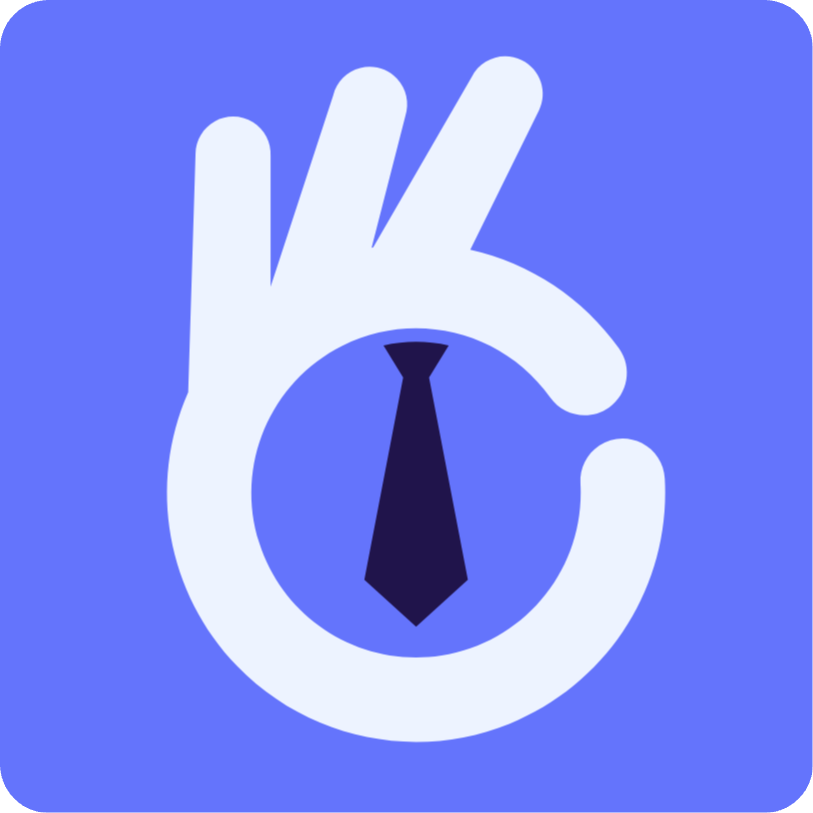 Interview Sidekick
Interview Sidekick